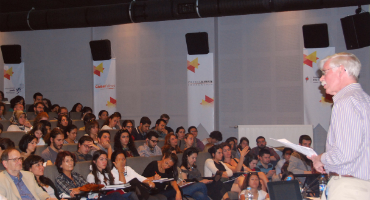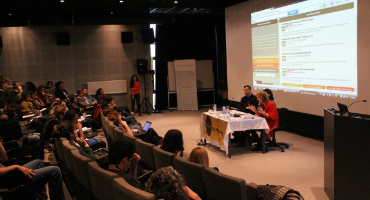The fifth event of thematic workshop series on discriminatory discourse in the media and rights-based approach to journalism, entitled ‘The Perception of the Enemy in the Media: Discriminatory Discourse against Religious and Ethnic Identities’ was organized in Havak Hall, Anarad Hığutyun Building on November, 26, 2015 by Hrant Dink Foundation. The workshop was held by the contributions of the speakers named Zeynep Arslan from Hrant Dink Foundation and İdil Engindeniz from Galatasaray University.
The background of the ‘Media Watch on Hate Speech’ project, which has been carried out since 2009 by the Hrant Dink Foundation, was presented by the coordinator of the project, Zeynep Arslan. Through the media watch of local and national newspapers, the study aims to combat discrimination and racism in the media, reveal hate speech and open up a space for discussion and share the findings with the public every four months. Arslan discussed the structural and methodological transformations the project has underwent since 2009 and emphasized that the scope of the project covers not only hate speech against ethnic and religious identities but also against LGBTI and women. At the same time, the discussion focused on the developments in the project from 2013 onwards. With 2013, an additional discriminatory discourse thematic file which aims to point out the discrimination in the media started to be prepared with focusing on particular events that takes place in a given time period. After informing the audience about the academic conferences and panels organized on hate speech and discriminatory discourse, Arslan gave a brief account of the workshops organized in order to introduce and disseminate the course syllabus prepared within the scope of the project in order to orient university students into the field of media and hate speech.
The rapporteur of the project, İdil Engindeniz, on monitoring the hate speech in national and local press pointed out that hate speech may be produced against different groups in different times based on the context. Engindeniz emphasized that within the scope of the study, the criteria of hate speech is based on its definition in the 1997 Recommendation accepted by the Committee of Ministers of the Council of Europe. In addition to sharing the prominent findings of the periodic reports, which have been prepared since 2009, Engindeniz analyzed the statistical changes in hate speech directed against religious and ethnic identities over the years. She also presented examples from newspaper columns and articles in order to explore how hate speech is not only directed against ethnic and religious groups, but also used to discredit LGBTI and women. Engindeniz underlined that such discourse is not produced at personal level but politically constructed and the main mechanism reproducing this discourse is the ‘us’ vs. ‘them’ dichotomy and the project aims to raise awareness by exposing this particular content. Engindeniz indicated that the majority of hate speech monitored are on newspapers and columns which mostly make constant reference to religious and ethnic identities. Moreover, Engindeniz stated that recently there is an increase of hate speech in the content of news and it is a matter of concern; however it should also be considered as a means to mobilize professional organizations and other sanction mechanisms.
Lastly, the different suggestions on the means to combat hate speech on media were discussed. As for solution suggestions, different studies for data collection were discussed. At the same time, different means to combat hate speech such as preparation of alternative curriculums, comparative research opportunities and the interference of professional organizations to eliminate hate speech were discussed.





